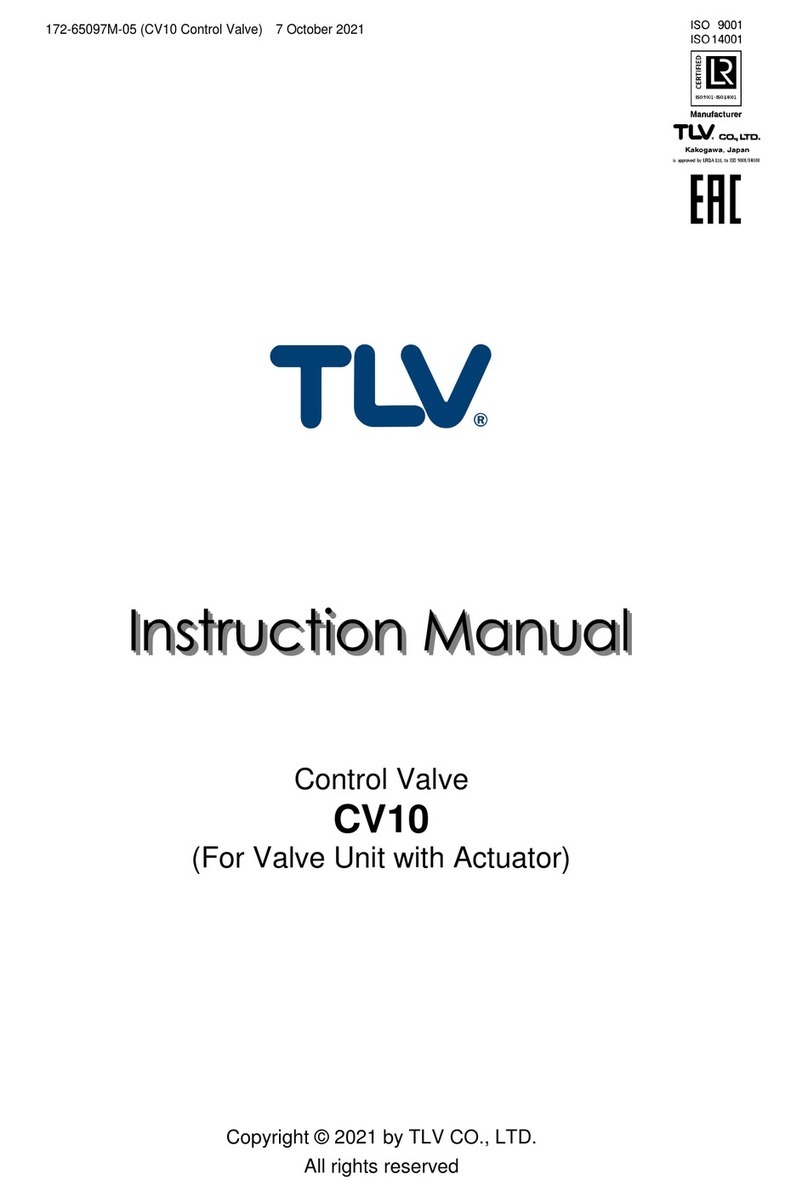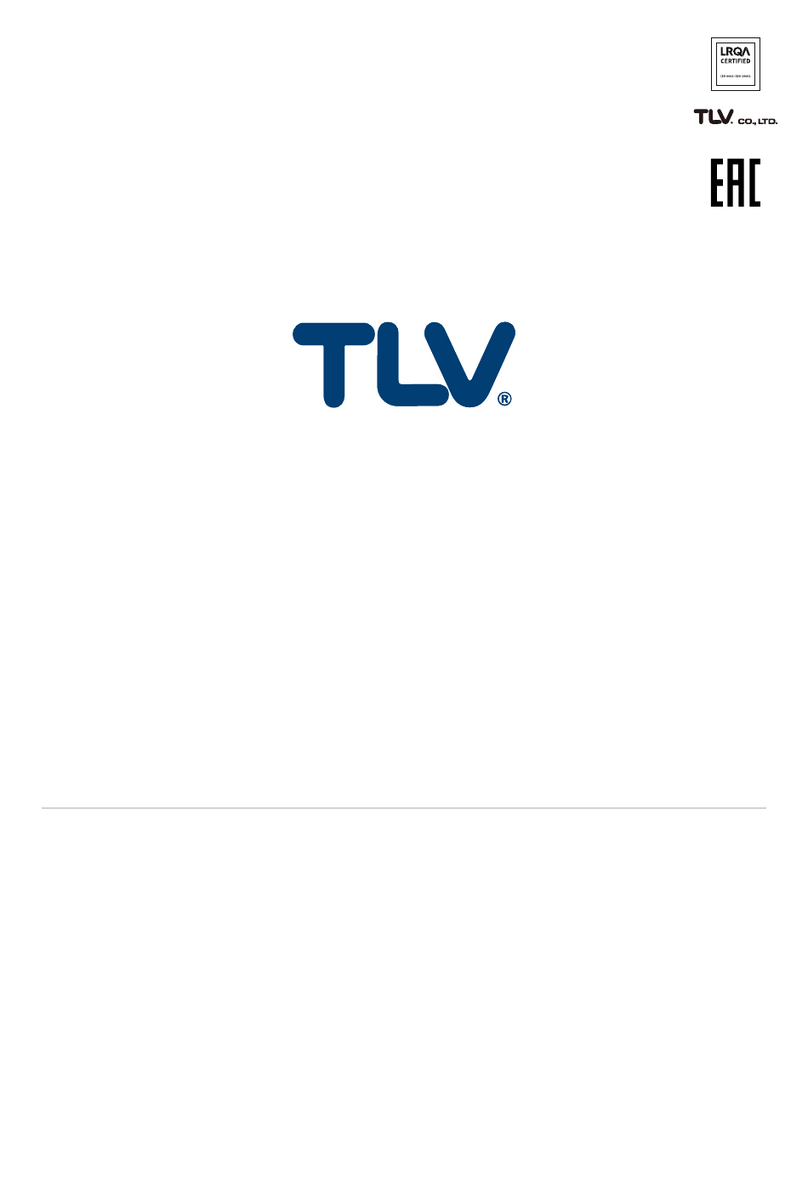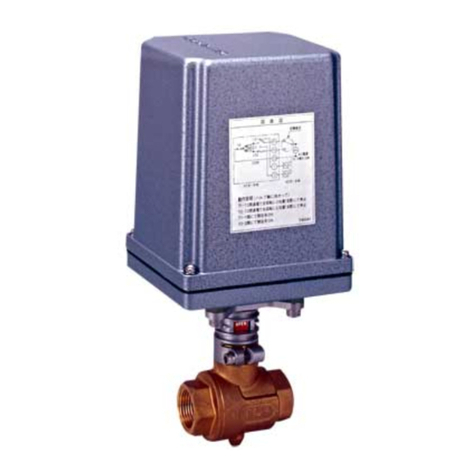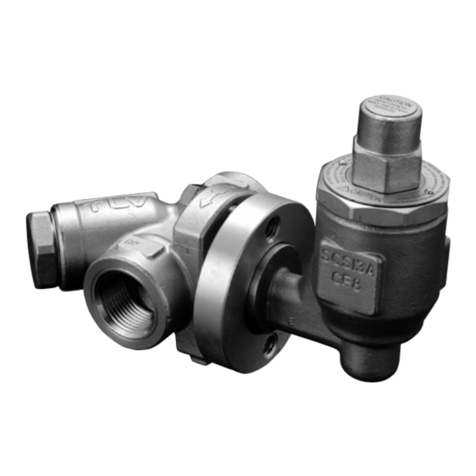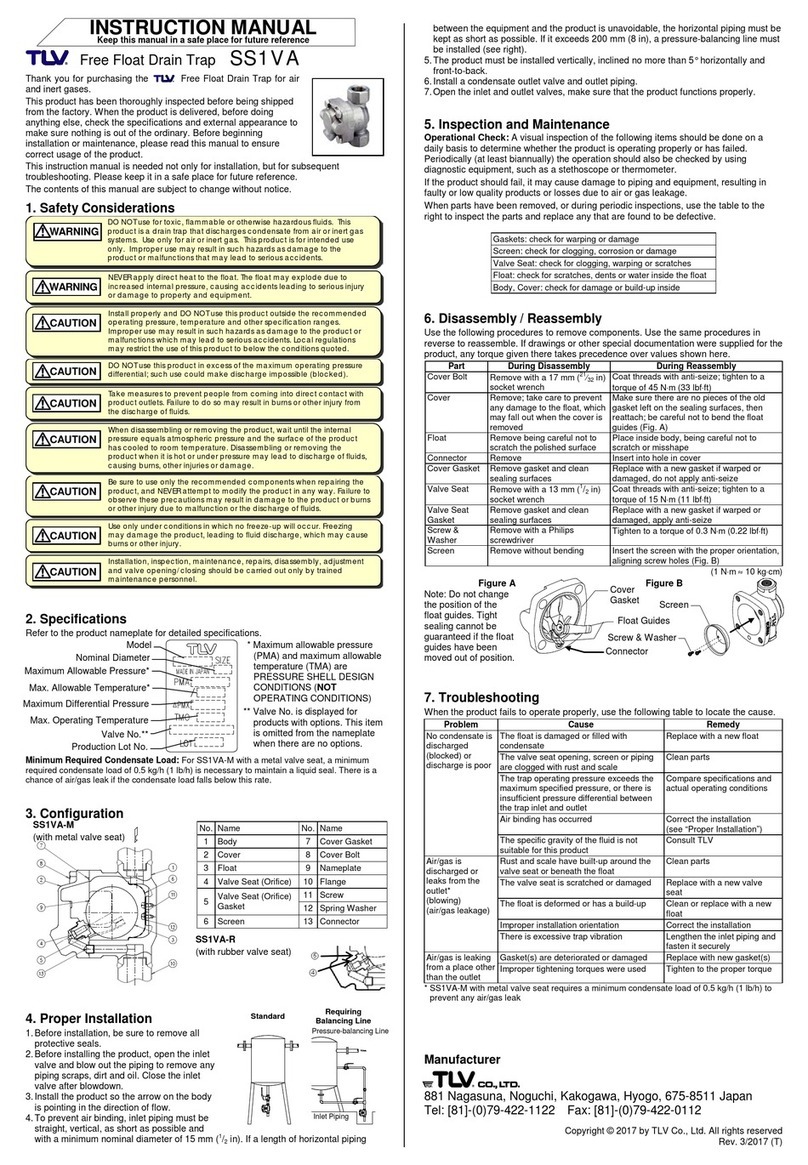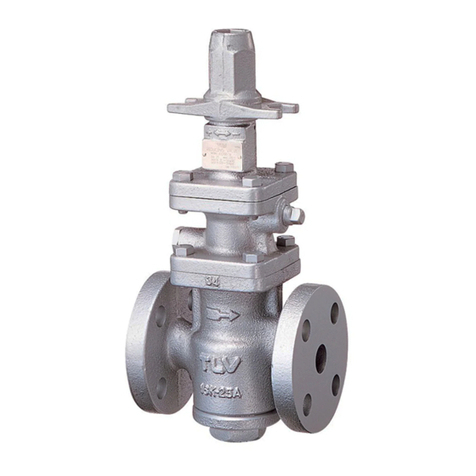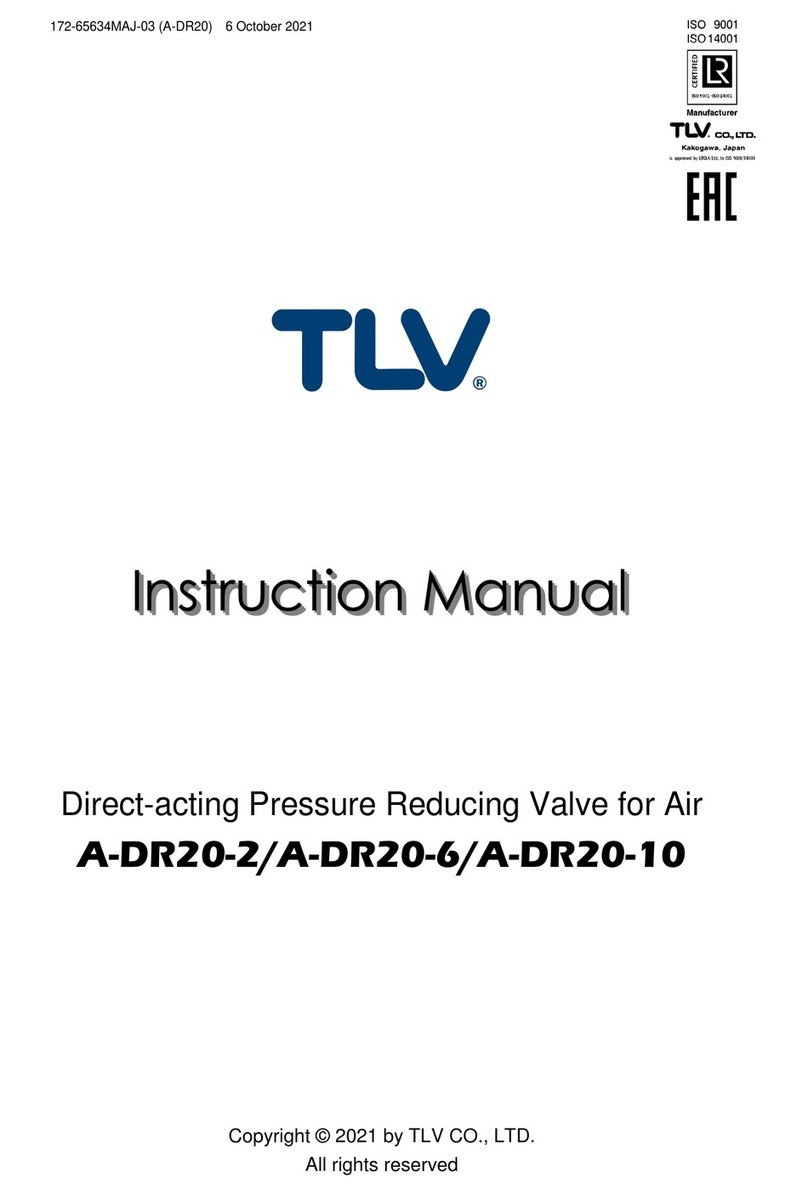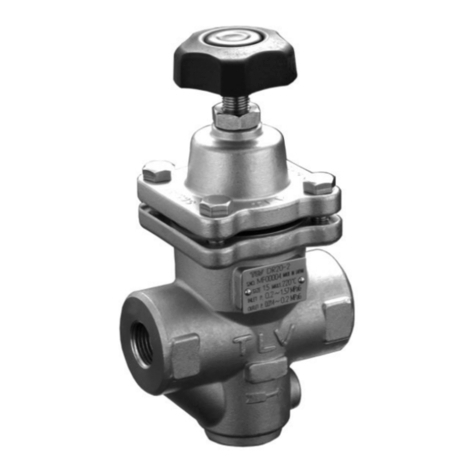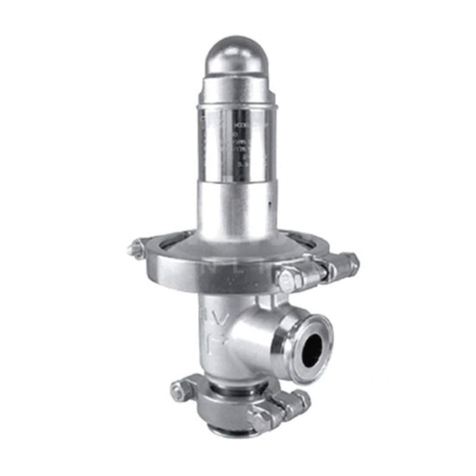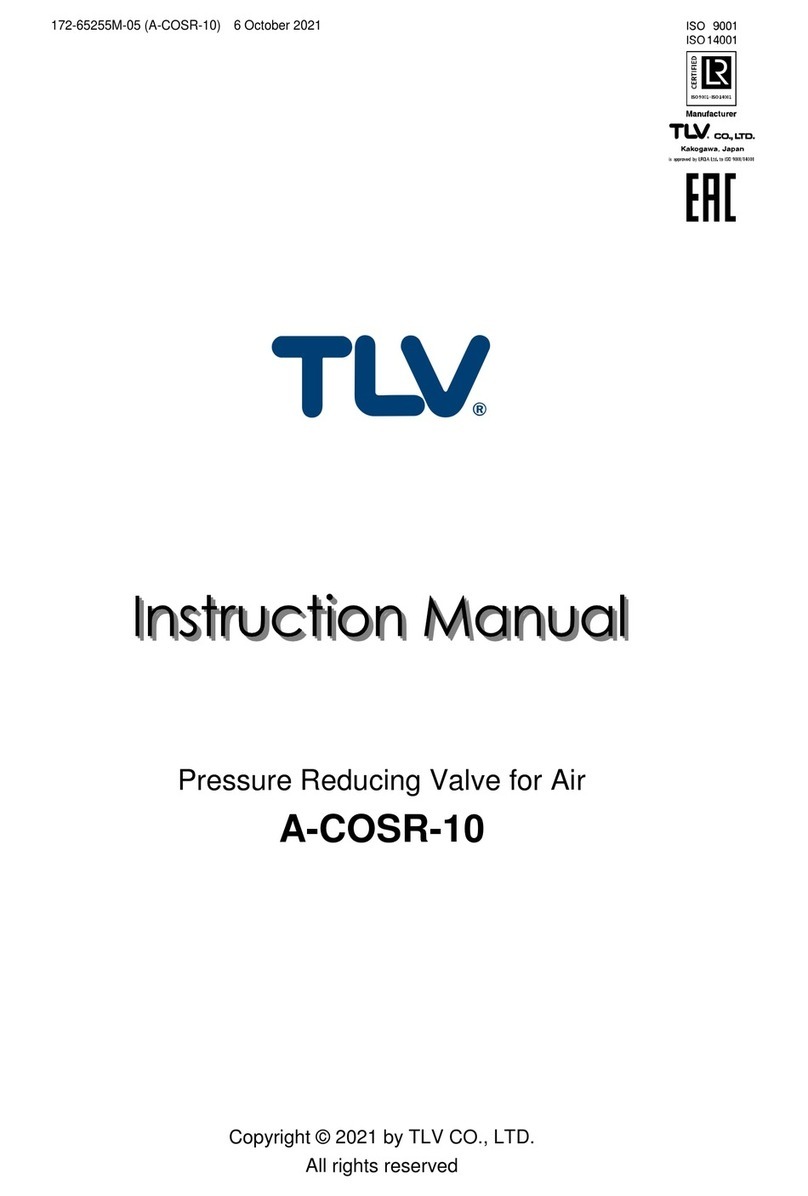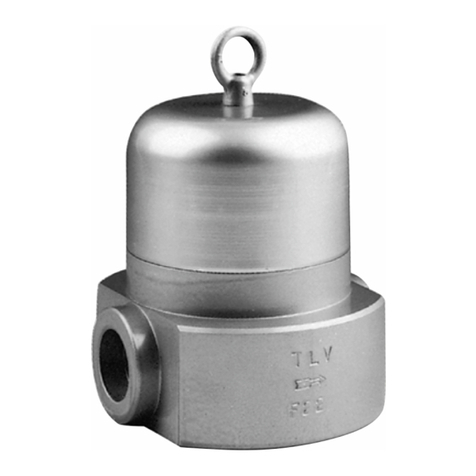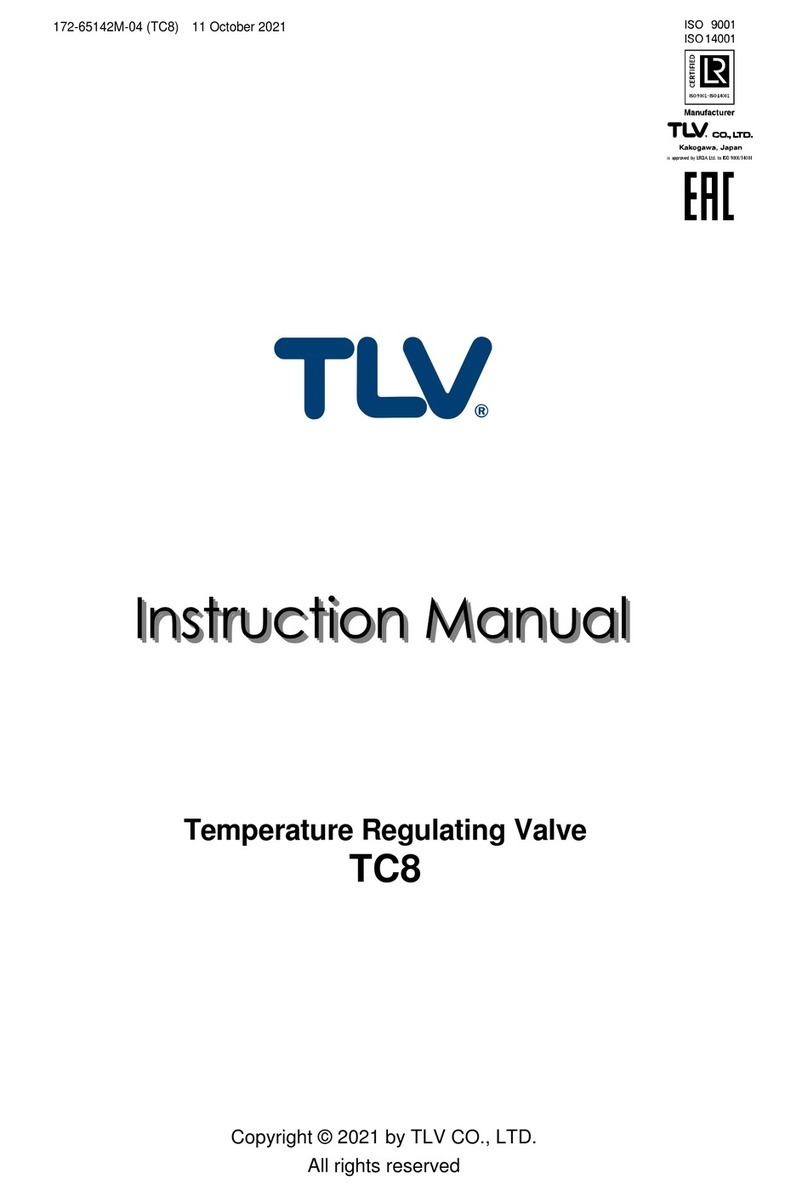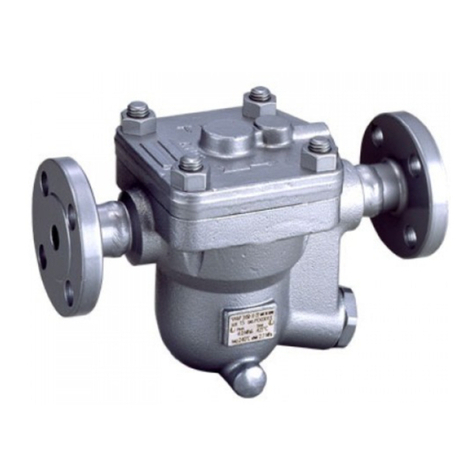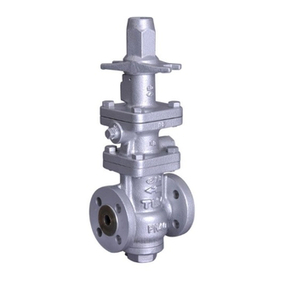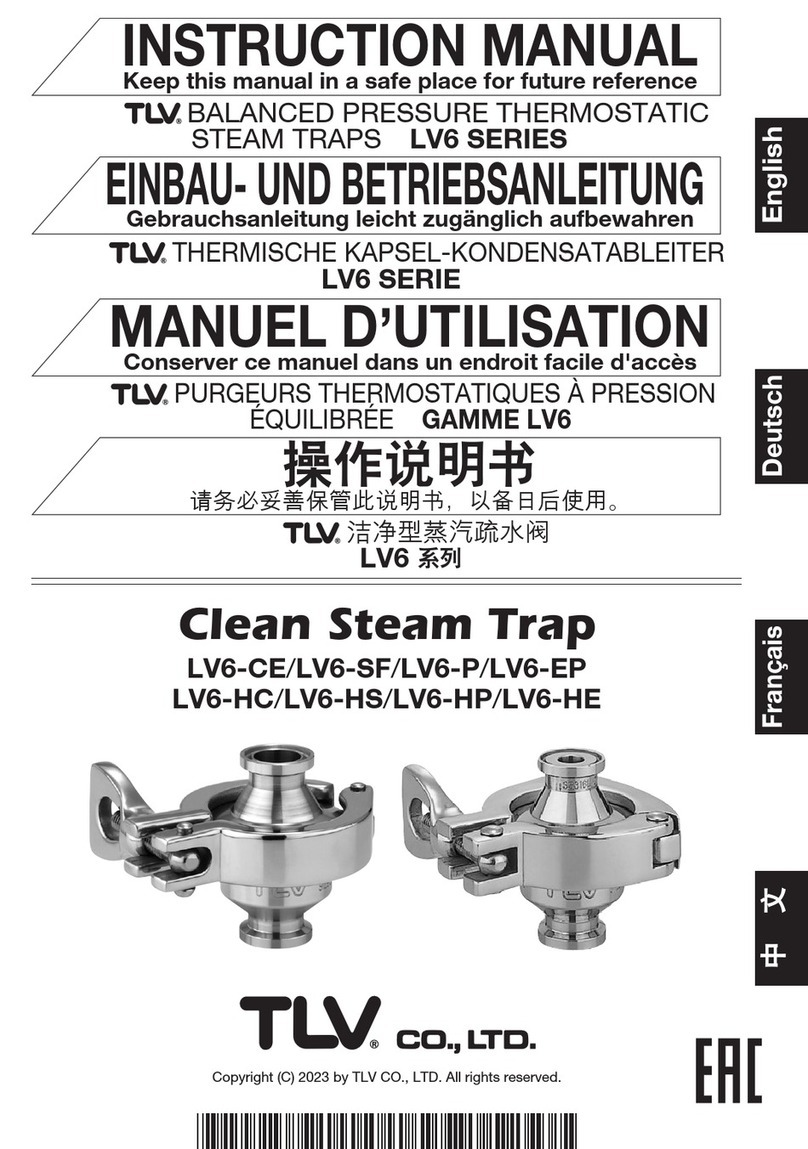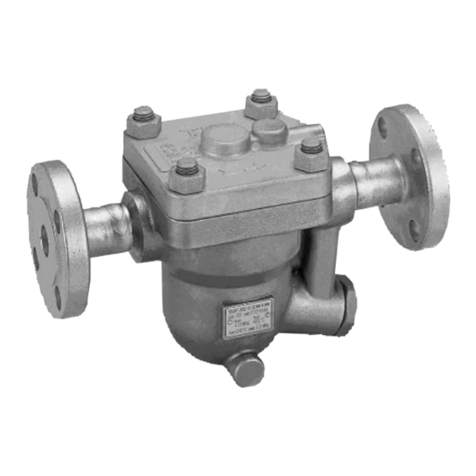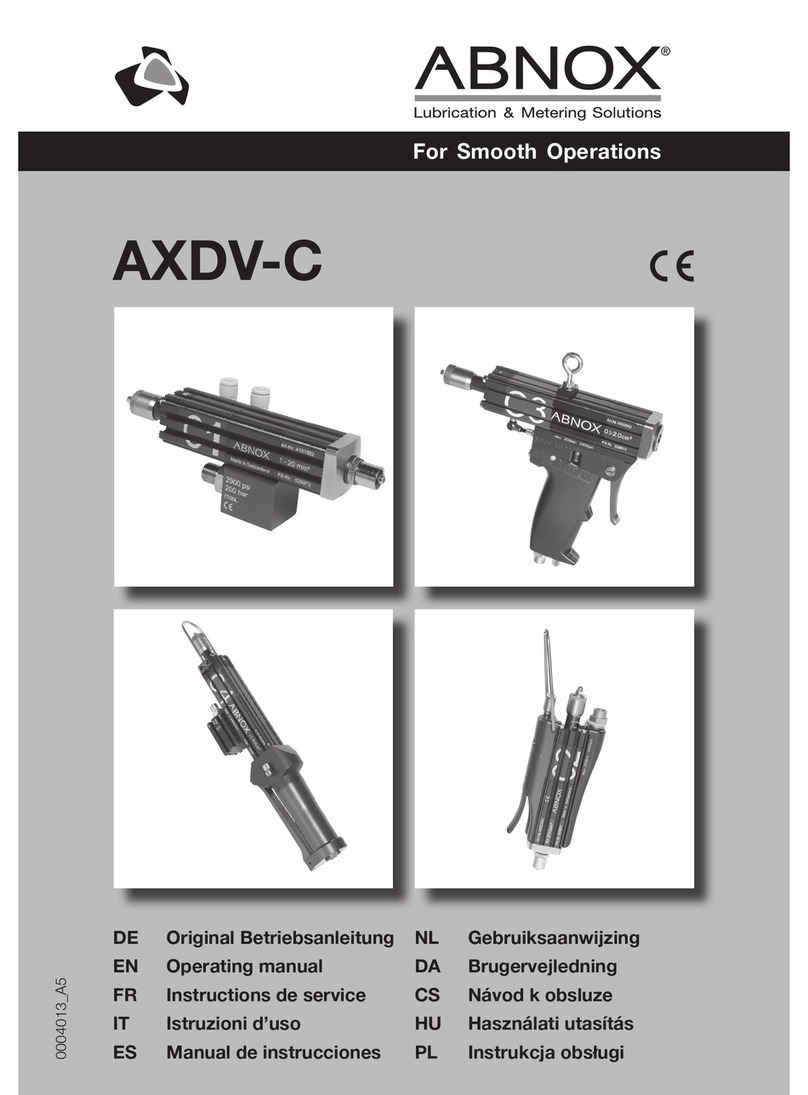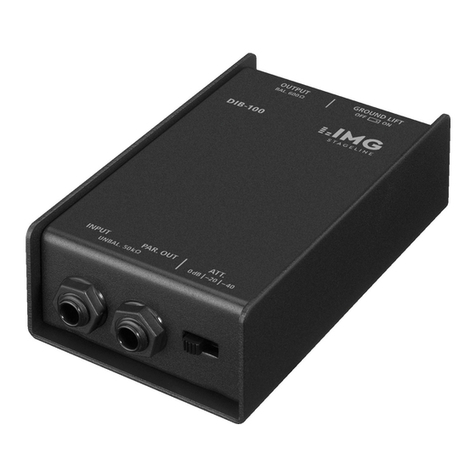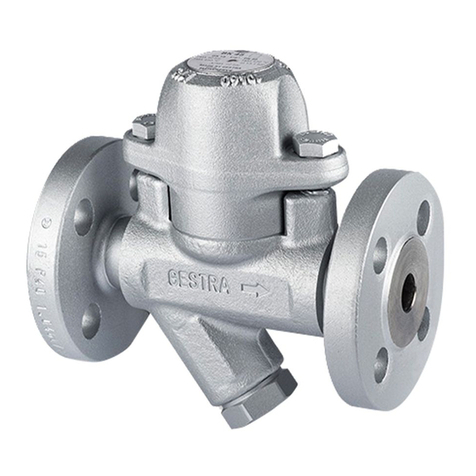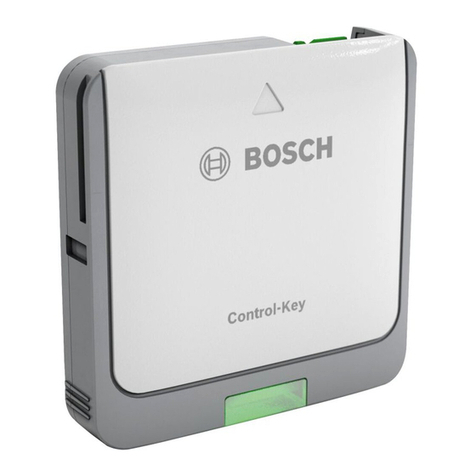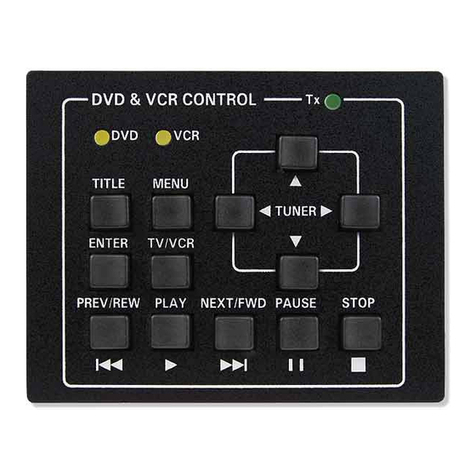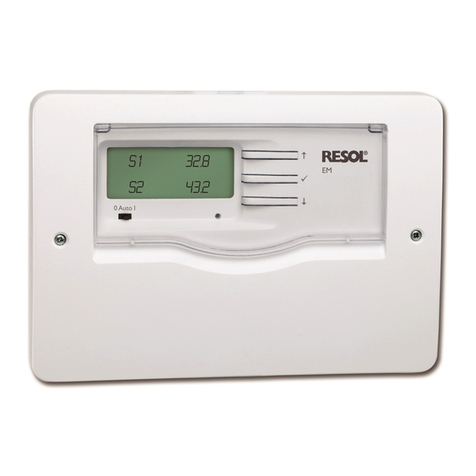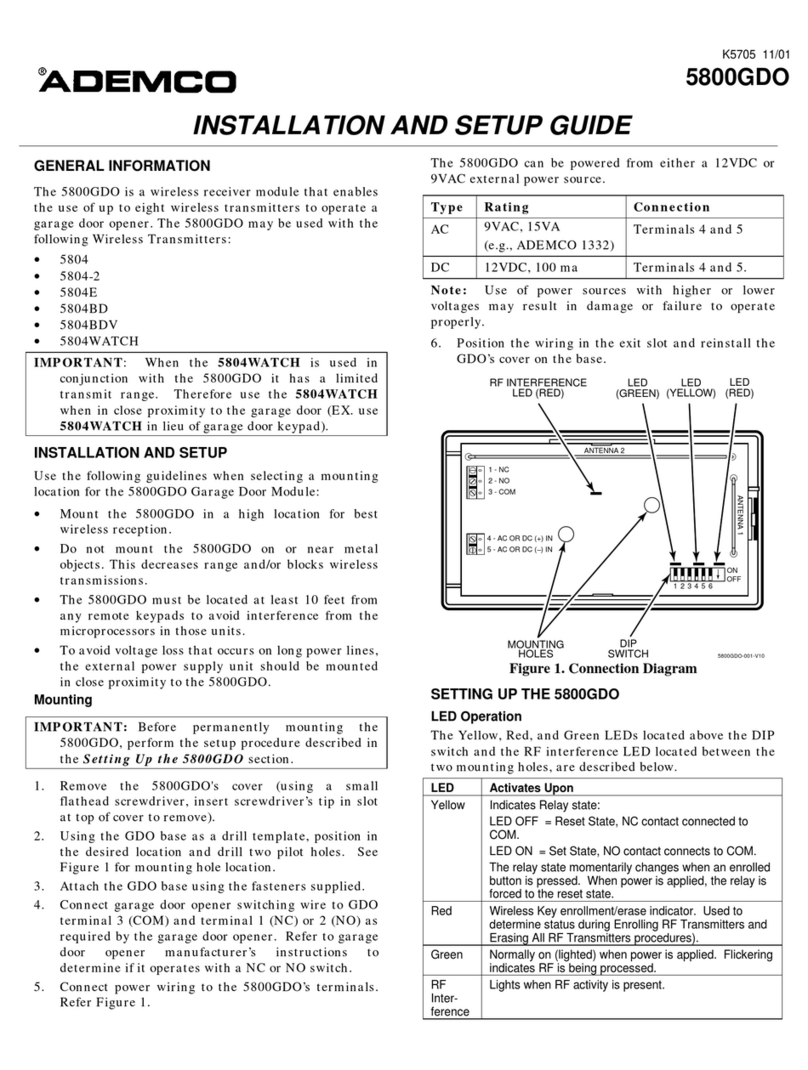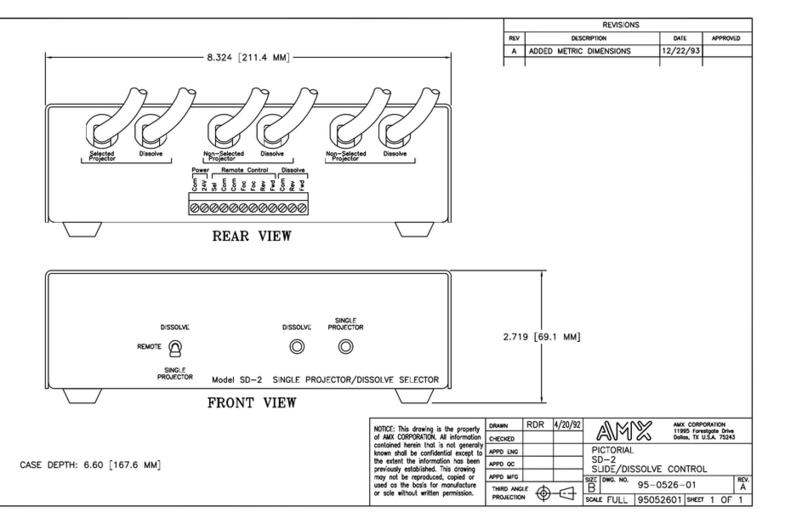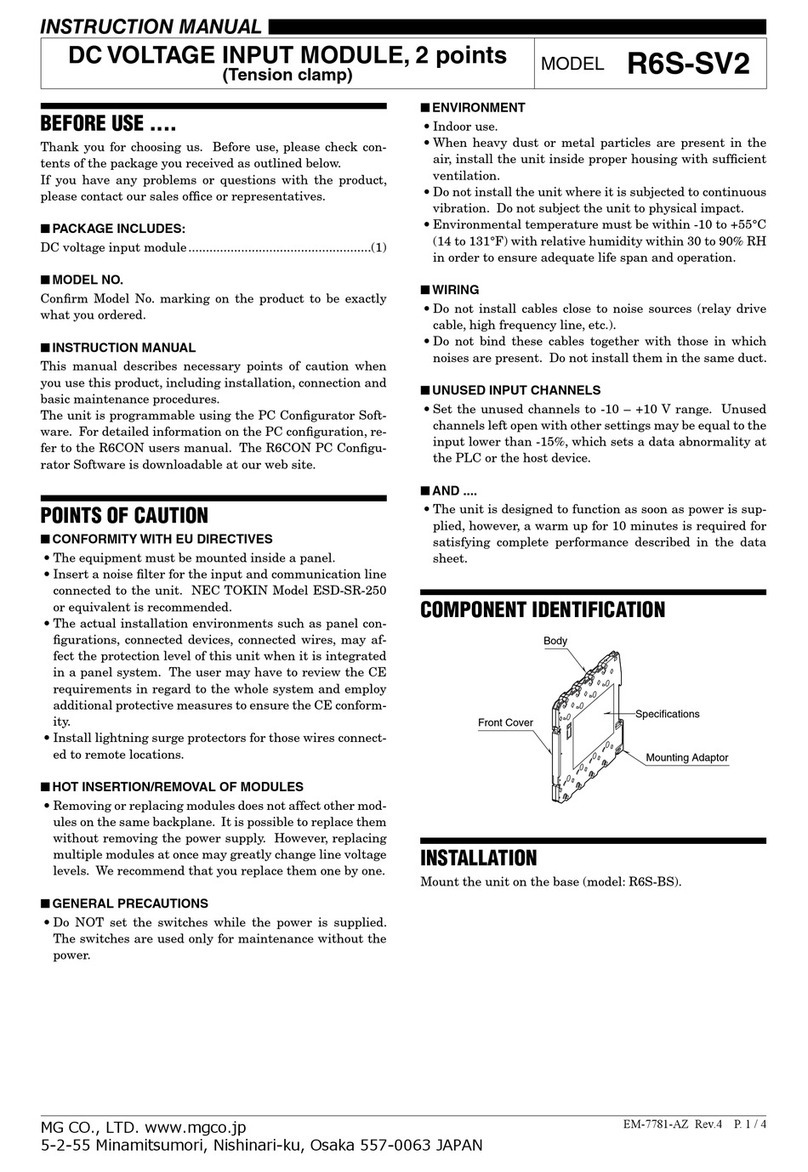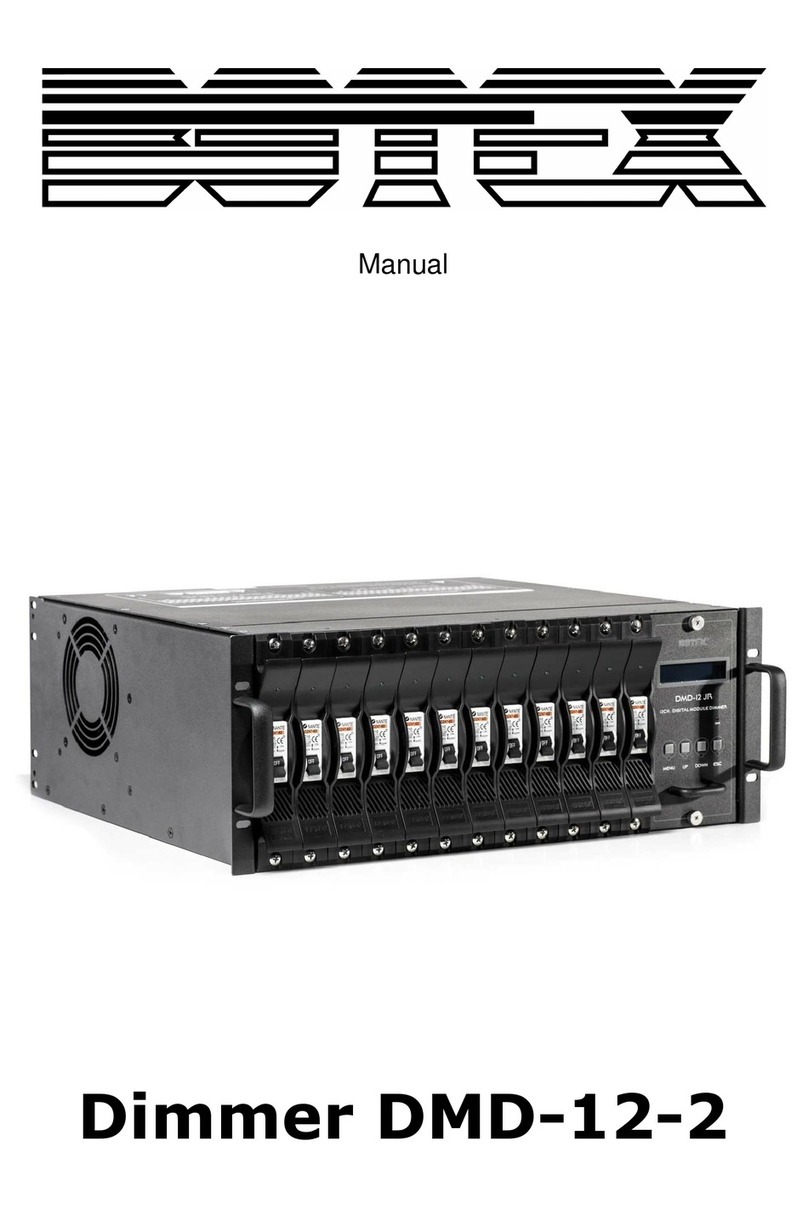TLV PCV-1 User manual

172-65200MA-07 (PCV-1) 8 October 2021
Surplussing Valve
(Primary Pressure Control Valve)
for Steam and Steam Condensate
PCV-1
Copyright © 2021 by TLV CO., LTD.
All rights reserved

172-65200MA-07 (PCV-1) 8 Oct 2021
1
Contents
Introduction .......................................................................1
Safety Considerations.......................................................2
Operation ..........................................................................4
Specifications....................................................................4
Configuration.....................................................................5
Installation.........................................................................6
Adjustment ........................................................................7
Maintenance......................................................................8
Disassembly/Reassembly.................................................9
Troubleshooting ..............................................................12
TLV EXPRESS LIMITED WARRANTY...........................13
Service............................................................................15
Introduction
Thank you for purchasing the TLV surplussing valve (primary pressure control valve)
for steam and steam condensate.
This product has been thoroughly inspected before being shipped from the factory.
When the product is delivered, before doing anything else, check the specifications
and external appearance to make sure nothing is out of the ordinary. Also be sure to
read this manual carefully before use and follow the instructions to be sure of using
the product properly.
TLV PCV-1 surplussing valve is a primary pressure adjusting valve for steam and
steam condensate. It features excellent responsiveness and stable operation with its
“direct acting pressure balance single-seated valve structure”that balances the
spring force and the primary pressure forcing through the pressure balance single-
seated valve and the piston.
If detailed instructions for special order specifications or options not contained in this
manual are required, please contact TLV for full details.
This instruction manual is intended for use with the model(s) listed on the front cover.
It is necessary not only for installation but for subsequent maintenance, disassembly/
reassembly and troubleshooting. Please keep it in a safe place for future reference.

172-65200MA-07 (PCV-1) 8 Oct 2021
2
Safety Considerations
Read this section carefully before use and be sure to follow the instructions.
Installation, inspection, maintenance, repairs, disassembly, adjustment and valve
opening/closing should be carried out only by trained maintenance personnel.
The precautions listed in this manual are designed to ensure safety and prevent
equipment damage and personal injury. For situations that may occur as a result of
erroneous handling, three different types of cautionary items are used to indicate
the degree of urgency and the scale of potential damage and danger: DANGER,
WARNING and CAUTION.
The three types of cautionary items above are very important for safety: be sure to
observe all of them as they relate to installation, use, maintenance, and repair.
Furthermore, TLV accepts no responsibility for any accidents or damage occurring
as a result of failure to observe these precautions.
Symbols
Indicates a DANGER, WARNING or CAUTION item.
Indicates an urgent situation which poses a threat of death or
serious injury
Indicates that there is a potential threat of death or serious injury
Indicates that there is a possibility of injury or equipment/product
damage
Install properly and DO NOT use this product outside the
recommended operating pressure, temperature and other
specification ranges.
Improper use may result in such hazards as damage to the
product or malfunctions that may lead to serious accidents. Local
regulations may restrict the use of this product to below the
conditions quoted.
Use hoisting equipment for heavy objects (weighting
approximately 20 kg (44 lb) or more).
Failure to do so may result in back strain or other injury if the
object should fall.
Take measures to prevent people from coming into direct
contact with product outlets.
Failure to do so may result in burns or other injury from the
discharge of fluids.
When disassembling or removing the product, wait until the
internal pressure equals atmospheric pressure and the
surface of the product has cooled to room temperature.
Disassembling or removing the product when it is hot or under
pressure may lead to discharge of fluids, causing burns, other
injuries or damage.
Continued on the next page
DANGER
WARNING
CAUTION
CAUTION

172-65200MA-07 (PCV-1) 8 Oct 2021
3
Be sure to use only the recommended components when
repairing the product, and NEVER attempt to modify the
product in any way.
Failure to observe these precautions may result in damage to the
product or burns or other injury due to malfunction or the
discharge of fluids.
When carrying out pressure adjustment etc., do not tighten
the adjustment screw further than its lower limit (when the
coil spring is fully compressed and the adjustment screw
cannot turn any further).
Failure to observe this precaution may damage the product,
leading to fluid discharge, which may cause burns or other injury.
Use only under conditions in which no freeze-up will occur.
Freezing may damage the product, leading to fluid discharge,
which may cause burns or other injury.
Use only under conditions in which no water hammer will
occur.
The impact of water hammer may damage the product, leading to
fluid discharge, which may cause burns or other injury.
CAUTION

172-65200MA-07 (PCV-1) 8 Oct 2021
4
Operation
NOTE: See the “Configuration”section for details.
Pressure on the primary side pressurizes the piston side through the pressure
passing port on the valve body. When the pressure exceeds the set pressure set by
the adjustment screw, the piston pushes the spring to open the valve and
consistently maintains pressure on the primary side by letting through the pressure
on the primary side to the secondary side.
Specifications
Install properly and DO NOT use this product outside the recommended
operating pressure, temperature and other specification ranges.
Improper use may result in such hazards as damage to the product or
malfunctions which may lead to serious accidents. Local regulations
may restrict the use of this product to below the conditions quoted.
CAUTION
Use only under conditions in which no freeze-up will occur. Freezing
may damage the product, leading to fluid discharge, which may cause
burns or other injury.
CAUTION
Refer to the product nameplate for detailed specifications.
* Maximum allowable pressure (PMA) and maximum allowable temperature (TMA) are
PRESSURE SHELL DESIGN CONDITIONS, NOT OPERATING CONDITIONS.
** Valve No. is displayed for products with options. This item is omitted from the
nameplate when there are no options.
Model
Production Lot No.
Maximum Allowable
Temperature (TMA)*
Maximum Operating
Temperature (TMO)
Nominal Diameter
Maximum Allowable
Pressure*
Maximum Operating
Pressure
Valve No.**

172-65200MA-07 (PCV-1) 8 Oct 2021
5
Configuration
No.
Name
1
Body
2
Bonnet
3
Valve Seat
4
O-ring (under Valve Seat)
5
Valve Body
6
O-ring (Valve Body)
7
Back-up Ring
8
O-ring (side of Valve Seat)
9
Gasket (Body/Bonnet)
10
Bolt (Body/Bonnet)
11
Nut (Body/Bonnet)
12
Connecting Rod
13
Gasket (Bonnet/Cylinder)
14
Cylinder
15
Piston
16
O-ring (Piston)
17
Gasket
(Connecting Rod/Piston)
18
O-ring (Connecting Rod)
19
Nut (Connecting Rod/Piston)
20
Cover
21
Coil Spring
22
Spring Retainer
23
Nut (Bonnet/Cover)
24
Adjustment Screw
25
Steel Ball
26
Cap
27
Locknut
28
Bolt (Bonnet/Cover)
29
Nameplate
30
Bolt (Body/Bonnet)
31
Bite Type Tube Fitting
32
Nut
(Connecting Rod/Valve
Body)
Pressure Passing Port

172-65200MA-07 (PCV-1) 8 Oct 2021
6
Installation
Install properly and DO NOT use this product outside the recommended
operating pressure, temperature and other specification ranges.
Improper use may result in such hazards as damage to the product or
malfunctions which may lead to serious accidents. Local regulations
may restrict the use of this product to below the conditions quoted.
CAUTION
Use hoisting equipment for heavy objects (weighing approximately
20 kg (44 lb) or more). Failure to do so may result in back strain or other
injury if the object should fall.
CAUTION
Take measures to prevent people from coming into direct contact with
product outlets. Failure to do so may result in burns or other injury from
the discharge of fluids.
CAUTION
Installation, inspection, maintenance, repairs, disassembly, adjustment and valve
opening/closing should be carried out only by trained maintenance personnel.
1. Before installation, be sure to remove all protective seals.
2. Before installing the product, blow out the inlet piping to remove any piping
scraps, dirt and oil. Close the inlet valve after blowdown.
3. Install the product so the arrow on the body is pointing in the direction of flow.
4. Support the inlet and outlet pipes securely to prevent vibration.
5. Leave sufficient space for adjusting the set pressure, maintenance, inspection
and repair.
6. Install a bypass valve for maintenance and inspection.
7. Install copper tube to the bite type tube fitting on the side of the cover and make
sure that the piping leads to a safe location such as a pit.
(Steam may blow when o-rings at piston are damaged.)
8. Do not install the product at locations where foreign matter accumulates in the
piping or water hammer occurs.
9. When installing the product on piping, make sure that the adjustment screw is
vertical to the horizontal piping and the cap stays at the top position.
If there is a problem, determine the cause using the “Troubleshooting” section in this
manual.

172-65200MA-07 (PCV-1) 8 Oct 2021
7
Adjustment
At the time of shipment, the product is not adjusted to the customer’s specified set
pressure.
By following the procedures below, adjust the primary pressure by adjusting the
adjustment screw of the PCV-1.
After removing the cap and loosening the locknut of the PCV-1, tightening the
adjustment screw clockwise increases the primary set pressure, and tightening it
counterclockwise decreases the primary set pressure.
1. After the PCV-1 is installed on the pipe, temporarily set the adjustment screw to
the desired primary pressure by referring to the graph “Relationship between the
Set Pressure and the Number of Turns of the Adjustment Screw”shown below.
The number of turns of the adjustment screw “0”on the graph is the position
where the adjustment screw starts to compress the coil spring.
In addition, follow this step when making adjustments before installing the product,
and follow the procedures below after installing the product.
2. Start supplying fluid slowly and watch the pressure on the primary side with a
pressure gauge.
3. When the pressure is different from the desired pressure, adjust the pressure to
the desired pressure by operating the adjustment screw.
4. After the pressure has been adjusted, retighten the locknut and replace the cap.
NOTE:
Set the pressure based on the number of turns of the adjustment screw
corresponding to the set pressure, as obtained in Step 1 (see graph below).
If the set pressure cannot be obtained even when the number of turns exceeds this
reference value by ± 2 turns, there may be some sort of abnormality.
Make sure the number of turns does not exceed the reference value by 2 turns, and
completely loosen the adjustment screw. Disassemble and clean the product following
the remedies in the “Troubleshooting” section, then reassemble the product.
After confirming that the adjustment screw is loose, set the number of turns again
according to the steps mentioned above.
The same steps are taken when there is an abnormal leak while the valve is fully closed.
Relationship between the set pressure and the
number of turns of the adjustment screw (Reference value)
No. of Turns of the Adjustment Screw*
(Clockwise)
Please refer to the PMO Value on
the nameplate to determine if 3.0
MPaG type or 1.0 MPaG type.
* Number of turns is from where the
adjustment screw starts to
compress the coil spring.
(1 MPa = 10.197 kg/cm2)
(1 MPa = 145 psi)
When carrying out pressure adjustment etc., do not tighten the
adjustment screw further than its lower limit (when the coil spring is fully
compressed and the adjustment screw cannot turn any further).
Failure to observe this precaution may damage the product, leading to
fluid discharge, which may cause burns or other injury.
CAUTION
3.0
2.5
2.0
1.5
1.0
0.5
0510 15 20 25
25 –65 mm
(1 –21/2in) 80, 100mm
(3, 4 in)
25 –65 mm
(1 –21/2in)
80, 100mm
(3, 4 in)
Set Pressure (MPaG)
3.0 MPaG type
1.0 MPaG type

172-65200MA-07 (PCV-1) 8 Oct 2021
8
Maintenance
Take measures to prevent people from coming into direct contact with
product outlets. Failure to do so may result in burns or other injury from
the discharge of fluids.
CAUTION
Be sure to use only the recommended components when repairing the
product, and NEVER attempt to modify the product in any way. Failure to
observe these precautions may result in damage to the product or burns
or other injury due to malfunction or the discharge of fluids.
CAUTION
Operational Check
A visual inspection of the following items should be done on a daily basis to
determine whether the product is operating properly or has failed. Periodically (at
least biannually) the operation should also be checked by using diagnostic
equipment, such as a stethoscope or pressure gauge.
Normal: Sound of fluid flow can be heard, and the primary pressure is maintained as
designed.
When the primary pressure is changed, readjust with the PCV-1 adjustment screw.
Parts Inspection
When parts have been removed, or during periodic inspections, use the following
table to inspect the parts and replace any that are found to be defective.
Procedure
Coil Spring:
Check for eccentricity, warping or scratches
Piston, Valve Body:
Check if the piston and valve body move
smoothly in the cylinder against the valve seat
Piston:
Check for deformation or scratches
Valve Body:
Check for deformation or scratches
O-ring:
Check for damages
Back-up Ring:
Check for damages
Nut:
Check if it is loosened
Valve Seat:
Check for deformation, scratches or build-up
Product Inspection
After performing maintenance work etc. which requires the removal of the product
from the installation location, confirm that any location where the product is to be
installed for any purpose or application (such as conducting a service check), is
within the service environment of the product specifications. After which, adjustment
should be carried out according to the “Adjustment”section.
When there is an abnormal leak even while the valve is fully closed, disassembly and
cleaning should be carried out according to the remedies in the “Troubleshooting”
section.
Do not tighten the adjustment screw +2 turns or more than the reference position.
When carrying out pressure adjustment etc., do not tighten the
adjustment screw further than its lower limit (when the coil spring is fully
compressed and the adjustment screw cannot turn any further).
Failure to observe this precaution may damage the product, leading to
fluid discharge, which may cause burns or other injury.
CAUTION

172-65200MA-07 (PCV-1) 8 Oct 2021
9
Disassembly/Reassembly
Use hoisting equipment for heavy objects (weighing approximately
20 kg (44 lb) or more). Failure to do so may result in back strain or other
injury if the object should fall.
CAUTION
When disassembling or removing the product, wait until the internal
pressure equals atmospheric pressure and the surface of the product
has cooled to room temperature. Disassembling or removing the
product when it is hot or under pressure may lead to discharge of fluids,
causing burns, other injuries or damage.
CAUTION
Be sure to use only the recommended components when repairing the
product, and NEVER attempt to modify the product in any way. Failure to
observe these precautions may result in damage to the product or burns
or other injury due to malfunction or the discharge of fluids.
CAUTION
When the product is disassembled or reassembled, make sure to loosen the
adjustment screw fully so that there will be no load on the coil spring.
Use the following procedures to remove components. Use the same procedures in
reverse to reassemble.
(Installation, inspection, maintenance, repairs, disassembly, adjustment and valve
opening/closing should be carried out only by trained maintenance personnel.)
Part
During Disassembly
During Reassembly
Cover
Loosen nuts (bonnet/cover) and
take out the spring retainer, steel
ball and the coil spring from the
inside after bolts (bonnet/cover)
and cover have been removed
Coat steel ball surface with heat
resistant grease before
reassembly; for bolts and nuts
(bonnet/cover), consult the table
of tightening torques and tighten
to the proper torque
Cylinder
Pull out vertically against the body
Remove and clean the remaining
gasket on the sealing surface and
reassemble
Gasket
(Bonnet/Cylinder)
Remove the gasket and clean
sealing surfaces
Replace with a new gasket; make
sure that the sealing surfaces are
clean
Nut
(Connecting Rod/
Piston)
Pull up the piston by hand until it
stops and hold the connecting rod
with a wrench at the two flat
surfaces on the rod, then remove
the piston by loosening the nut on
the upper part of connecting rod
Consult the table of tightening
torques and tighten to the proper
torque
O-rings
(Piston)
Remove o-rings on the piston
Replace with new o-rings; be sure
to coat surfaces with heat
resistant grease
O-rings
(for Connecting
Rod)
Remove o-rings
Replace with new o-rings; be sure
to coat surfaces with heat
resistant grease
Bonnet
Remove nuts (body/bonnet) and
pull out the bonnet vertically.
Be careful not to scratch the
sealing surface
Remove and clean the remaining
gasket on the sealing surface and
reassemble; consult the table of
tightening torques and tighten to
the proper torque
Connecting Rod
Pull out the connecting rod
together with the valve body
vertically against the body
Insert the valve body connected to
the connecting rod in the valve
seat by making sure that o-rings of
the valve body are in appropriate
places

172-65200MA-07 (PCV-1) 8 Oct 2021
10
Part
During Disassembly
During Reassembly
Valve Body
Nut
(Connecting Rod/
Valve Body)
Hold the connecting rod with a
wrench at the two flat surfaces on
the rod and remove the valve
body with a socket wrench by
removing the nut connecting the
valve body
Consult the table of tightening
torques and tighten to the proper
torque
O-rings
Back-up Rings
(Valve Body)
Remove o-rings/back-up rings on
the valve body
Replace with new o-rings; be sure
to coat surfaces with heat
resistant grease
Valve Seat
Remove the valve seat from the
body
Insert the valve seat slowly by
making sure that o-rings are in
appropriate places
O-rings
(ValveSeat:2types)
Remove o-rings on the side and
the bottom of the valve seat
Replace with new o-rings; be sure
to coat surfaces with heat
resistant grease
Table of Tightening Torques
Part Name
Size
Distance Across Flats
Torque
(mm)
(in)
(mm)
(in)
(N·m)
(lbf·ft)
Nut
(Bonnet/Cover)
25 - 65
(1 –21/2)
16
(5/8)
80
(59)
80 - 100
(3 –4)
19
(3/4)
180
(130)
Nut
(Body/Bonnet)
25
(1)
19
(3/4)
100
(81)
40 - 50
(11/2–2)
19
(3/4)
200
(150)
65
(21/2)
24
(15/16)
200
(150)
80 - 100
(3 –4)
24
(15/16)
300
(220)
Nut (Connecting
Rod/Piston)
25 - 65
(1 –21/2)
17
(21/32)
40
(29)
80 - 100
(3 –4)
19
(3/4)
60
(44)
Nut
(Connecting Rod/
Valve Body)
25
(1)
10
(3/8)
25
(19)
40 - 65
(11/2–21/2)
17
(21/32)
40
(29)
80 - 100
(3 –4)
19
(3/4)
60
(44)
Connecting Rod
(at two flat surfaces)
25 - 65
(1 –21/2)
10
(3/8)
–
–
80 - 100
(3 –4)
17
(21/32)
–
–
NOTE: - If a torque greater than that recommended is applied, (1 Nm 10 kgcm)
the body or components may be damaged.
- Coat all threaded portions with anti-seize.
- If drawings or other special documentation were supplied for the product, any
torque given there takes precedence over values shown here.
Minimum Required Space for Disassembly
Size
H
mm
(in)
mm
(in)
25
(1)
590
(231/4)
40
(11/2)
600
(235/8)
50
(2)
65
(21/2)
620
(243/8)
80
(3)
840
(33)
100
(4)
H

172-65200MA-07 (PCV-1) 8 Oct 2021
11
Exploded View
O-ring
Piston
Gasket
(Bonnet/
Cylinder)
Bonnet
Gasket
(Body/Bonnet)
Cylinder
Nut
(Connecting Rod/Piston)
Gasket (Connecting Rod/Piston)
O-ring (Connecting Rod)
Connecting
Rod Backing-up Ring
Valve Body
O-ring (Valve Seat Side)
Bolt (Body/Bonnet)
Body
Coil Spring
Steel Ball
Spring
Retainer
Bite Type
Tube Fitting
Nameplate
Bolt
(Bonnet/Cover)
Cap
Nut
(Bonnet/Cover)
Nut
(Body/
Bonnet)
O-ring
(Under Valve Seat)
Adjustment
Screw
Locknut
Cover
Valve Seat
O-ring
(Valve Body)
Nut (Connecting Rod/
Valve Body)
B
i
t
e
T
y
p
e
T
u
b
e
F
i
t
t
i
n
g

172-65200MA-07 (PCV-1) 8 Oct 2021
12
Troubleshooting
When disassembling or removing the product, wait until the internal
pressure equals atmospheric pressure and the surface of the product
has cooled to room temperature. Disassembling or removing the
product when it is hot or under pressure may lead to discharge of fluids,
causing burns, other injuries or damage.
CAUTION
When the product fails to operate properly, use the following table to locate the cause
and remedy.
Problem
Cause
Diagnosis
Remedy
The primary pressure
increases abnormally
The flow rate is
insufficient
Valve is not open
as its initial setting
Piston/valve body
do not slide due to
scale or build-up
Clean piston,
cylinder, valve body
and valve seat
Replace each
o-ring/back-up ring
with new one
The primary pressure
decreases
Fluid leaks when the
valve is fully closed
Supply pressure is
decreased
Check the supply
pressure
Set the supply
pressure back to
the given pressure
Valve isn’t
completely closed
Valve is leaking
O-ring under the
valve seat is
damaged, or rust or
scale on the valve
seat/valve body
Replace with a new
o-ring
Clean the valve
seat and the valve
body
(* See NOTE)
Fluid leaks from the
bite type tube fitting on
the side of the cover
Insufficient sealing
of the o-rings on the
piston
Piston o-rings are
damaged
Replace with new
o-rings
* NOTE: Leakage may occur even when the valve is completely closed during operation.
Leakage when the valve is completely closed cannot be stopped by tightening the
adjustment screw.
Do not overtighten the adjustment screw to stop leakage.
If the leak does not stop even after making an adjustment based on the "Relationship
between the set pressure and the number of turns of the adjustment screw", replace
the applicable parts
When carrying out pressure adjustment etc., do not tighten the
adjustment screw further than its lower limit (when the coil spring is fully
compressed and the adjustment screw cannot turn any further).
Failure to observe this precaution may damage the product, leading to
fluid discharge, which may cause burns or other injury.
CAUTION

172-65200MA-07 (PCV-1) 8 Oct 2021
13
TLV EXPRESS LIMITED WARRANTY
Subject to the limitations set forth below, TLV CO., LTD., a Japanese corporation
(“TLV”), warrants that products which are sold by it, TLV International Inc. (“TII”) or
one of its group companies excluding TLV Corporation (a corporation of the United
States of America), (hereinafter the “Products”) are designed and manufactured by
TLV, conform to the specifications published by TLV for the corresponding part
numbers (the “Specifications”) and are free from defective workmanship and
materials. The party from whom the Products were purchased shall be known
hereinafter as the “Seller”. With regard to products or components manufactured by
unrelated third parties (the “Components”), TLV provides no warranty other than the
warranty from the third party manufacturer(s), if any.
Exceptions to Warranty
This warranty does not cover defects or failures caused by:
1. improper shipping, installation, use, handling, etc., by persons other than TLV,
TII or TLV group company personnel, or service representatives authorized by
TLV; or
2. dirt, scale or rust, etc.; or
3. improper disassembly and reassembly, or inadequate inspection and
maintenance by persons other than TLV or TLV group company personnel, or
service representatives authorized by TLV; or
4. disasters or forces of nature or Acts of God; or
5. abuse, abnormal use, accidents or any other cause beyond the control of TLV,
TII or TLV group companies; or
6. improper storage, maintenance or repair; or
7. operation of the Products not in accordance with instructions issued with the
Products or with accepted industry practices; or
8. use for a purpose or in a manner for which the Products were not intended; or
9. use of the Products in a manner inconsistent with the Specifications; or
10. use of the Products with Hazardous Fluids (fluids other than steam, air, water,
nitrogen, carbon dioxide and inert gases (helium, neon, argon, krypton, xenon
and radon)); or
11. failure to follow the instructions contained in the TLV Instruction Manual for the
Product.
Duration of Warranty
This warranty is effective for a period of one (1) year after delivery of Products to the
first end user. Notwithstanding the foregoing, asserting a claim under this warranty
must be brought within three (3) years after the date of delivery to the initial buyer if
not sold initially to the first end user.
ANY IMPLIED WARRANTIES NOT NEGATED HEREBY WHICH MAY ARISE BY
OPERATION OF LAW, INCLUDING THE IMPLIED WARRANTIES OF MERCHANTABILITY
AND FITNESS FOR A PARTICULAR PURPOSE AND ANY EXPRESS WARRANTIES NOT
NEGATED HEREBY, ARE GIVEN SOLELY TO THE INITIAL BUYER AND ARE LIMITED IN
DURATION TO ONE (1) YEAR FROM THE DATE OF SHIPMENT BY THE SELLER.
Exclusive Remedy
THE EXCLUSIVE REMEDY UNDER THIS WARRANTY, UNDER ANY EXPRESS
WARRANTY OR UNDER ANY IMPLIED WARRANTIES NOT NEGATED HEREBY
(INCLUDING THE IMPLIED WARRANTIES OF MERCHANTABILITY AND FITNESS FOR A
PARTICULAR PURPOSE), IS REPLACEMENT; PROVIDED: (a) THE CLAIMED DEFECT IS

172-65200MA-07 (PCV-1) 8 Oct 2021
14
REPORTED TO THE SELLER IN WRITING WITHIN THE WARRANTY PERIOD, INCLUDING
A DETAILED WRITTEN DESCRIPTION OF THE CLAIMED DEFECT AND HOW AND WHEN
THE CLAIMED DEFECTIVE PRODUCT WAS USED; AND (b) THE CLAIMED DEFECTIVE
PRODUCT AND A COPY OF THE PURCHASE INVOICE IS RETURNED TO THE SELLER,
FREIGHT AND TRANSPORTATION COSTS PREPAID, UNDER A RETURN MATERIAL
AUTHORIZATION AND TRACKING NUMBER ISSUED BY THE SELLER. ALL LABOR
COSTS, SHIPPING COSTS, AND TRANSPORTATION COSTS ASSOCIATED WITH THE
RETURN OR REPLACEMENT OF THE CLAIMED DEFECTIVE PRODUCT ARE SOLELY
THE RESPONSIBILITY OF BUYER OR THE FIRST END USER. THE SELLER RESERVES
THE RIGHT TO INSPECT ON THE FIRST END USER’S SITE ANY PRODUCTS CLAIMED
TO BE DEFECTIVE BEFORE ISSUING A RETURN MATERIAL AUTHORIZATION. SHOULD
SUCH INSPECTION REVEAL, IN THE SELLER’S REASONABLE DISCRETION, THAT THE
CLAIMED DEFECT IS NOT COVERED BY THIS WARRANTY, THE PARTY ASSERTING
THIS WARRANTY SHALL PAY THE SELLER FOR THE TIME AND EXPENSES RELATED
TO SUCH ON-SITE INSPECTION.
Exclusion of Consequential and Incidental Damages
IT IS SPECIFICALLY ACKNOWLEDGED THAT THIS WARRANTY, ANY OTHER EXPRESS
WARRANTY NOT NEGATED HEREBY, AND ANY IMPLIED WARRANTY NOT NEGATED
HEREBY, INCLUDING THE IMPLIED WARRANTIES OF MERCHANTABILITY AND FITNESS
FOR A PARTICULAR PURPOSE, DO NOT COVER, AND NEITHER TLV, TII NOR ITS TLV
GROUP COMPANIES WILL IN ANY EVENT BE LIABLE FOR, INCIDENTAL OR
CONSEQUENTIAL DAMAGES, INCLUDING, BUT NOT LIMITED TO LOST PROFITS, THE
COST OF DISASSEMBLY AND SHIPMENT OF THE DEFECTIVE PRODUCT, INJURY TO
OTHER PROPERTY, DAMAGE TO BUYER’S OR THE FIRST END USER’S PRODUCT,
DAMAGE TO BUYER’S OR THE FIRST END USER’S PROCESSES, LOSS OF USE, OR
OTHER COMMERCIAL LOSSES. WHERE, DUE TO OPERATION OF LAW,
CONSEQUENTIAL AND INCIDENTAL DAMAGES UNDER THIS WARRANTY, UNDER ANY
OTHER EXPRESS WARRANTY NOT NEGATED HEREBY OR UNDER ANY IMPLIED
WARRANTY NOT NEGATED HEREBY (INCLUDING THE IMPLIED WARRANTIES OF
MERCHANTABILITY AND FITNESS FOR A PARTICULAR PURPOSE) CANNOT BE
EXCLUDED, SUCH DAMAGES ARE EXPRESSLY LIMITED IN AMOUNT TO THE
PURCHASE PRICE OF THE DEFECTIVE PRODUCT. THIS EXCLUSION OF
CONSEQUENTIAL AND INCIDENTAL DAMAGES, AND THE PROVISION OF THIS
WARRANTY LIMITING REMEDIES HEREUNDER TO REPLACEMENT, ARE INDEPENDENT
PROVISIONS, AND ANY DETERMINATION THAT THE LIMITATION OF REMEDIES FAILS
OF ITS ESSENTIAL PURPOSE OR ANY OTHER DETERMINATION THAT EITHER OF THE
ABOVE REMEDIES IS UNENFORCEABLE, SHALL NOT BE CONSTRUED TO MAKE THE
OTHER PROVISIONS UNENFORCEABLE.
Exclusion of Other Warranties
THIS WARRANTY IS IN LIEU OF ALL OTHER WARRANTIES, EXPRESS OR IMPLIED,
AND ALL OTHER WARRANTIES, INCLUDING BUT NOT LIMITED TO THE IMPLIED
WARRANTIES OF MERCHANTABILITY AND FITNESS FOR A PARTICULAR PURPOSE,
ARE EXPRESSLY DISCLAIMED.
Severability
Any provision of this warranty which is invalid, prohibited or unenforceable in any
jurisdiction shall, as to such jurisdiction, be ineffective to the extent of such invalidity,
prohibition or unenforceability without invalidating the remaining provisions hereof,
and any such invalidity, prohibition or unenforceability in any such jurisdiction shall
not invalidate or render unenforceable such provision in any other jurisdiction.

172-65200MA-07 (PCV-1) 8 Oct 2021
15
Service
For Service or Technical Assistance: Contact your TLV representative or your regional
TLV office.
In Europe:
Daimler-Benz-Straße 16-18, 74915 Waibstadt, Germany
Tel:
Fax:
[49]-(0)7263-9150-0
[49]-(0)7263-9150-50
Units 7 & 8, Furlong Business Park, Bishops Cleeve, Gloucestershire GL52
8TW, U.K.
Tel:
Fax:
[44]-(0)1242-227223
[44]-(0)1242-223077
Parc d’Ariane 2, bât. C, 290 rue Ferdinand Perrier, 69800 Saint Priest,
France
Tel:
Fax:
[33]–(0)4-72482222
[33]-(0)4-72482220
In North America:
13901 South Lakes Drive, Charlotte, NC 28273-6790, U.S.A.
Tel:
Fax:
[1]-704-597-9070
[1]-704-583-1610
In Mexico and Latin America:
Av. Jesús del Monte 39-B-1001, Col. Hda. de las Palmas, Huixquilucan,
Edo. de México, 52763, Mexico
Tel:
Fax:
[52]-55-5359-7949
[52]-55-5359-7585
In Oceania:
Unit 8, 137-145 Rooks Road, Nunawading, Victoria 3131, Australia
Tel:
Fax:
[61]-(0)3-9873 5610
[61]-(0)3-9873 5010
In East Asia:
36 Kaki Bukit Place, #02-01/02, Singapore 416214
Tel:
Fax:
[65]-6747 4600
[65]-6742 0345
Room 5406, No. 103 Cao Bao Road, Shanghai, China 200233
Tel:
Fax:
[86]-(0)21-6482-8622
[86]-(0)21-6482-8623
No.16, Jalan MJ14, Taman Industri Meranti Jaya, 47120 Puchong,
Selangor, Malaysia
Tel:
Fax:
[60]-3-8065-2928
[60]-3-8065-2923
252/94 (K-L) 17th Floor, Muang Thai-Phatra Complex Tower B,
Rachadaphisek Road, Huaykwang, Bangkok 10310, Thailand
Tel:
Fax:
[66]-2-693-3799
[66]-2-693-3979
#302-1 Bundang Technopark B, 723 Pangyo-ro, Bundang, Seongnam,
Gyeonggi, 13511, Korea
Tel:
Fax:
[82]-(0)31-726-2105
[82]-(0)31-726-2195
In the Middle East:
Building 2W, No. M002, PO Box 371684, Dubai Airport Free Zone, Dubai, UAE
Email:
In Other Countries:
881 Nagasuna, Noguchi, Kakogawa, Hyogo 675-8511, Japan
Tel:
Fax:
[81]-(0)79-427-1818
[81]-(0)79-425-1167
Manufacturer:
881 Nagasuna, Noguchi, Kakogawa, Hyogo 675-8511, Japan
Tel:
Fax:
[81]-(0)79-422-1122
[81]-(0)79-422-0112
Table of contents
Other TLV Control Unit manuals
Popular Control Unit manuals by other brands
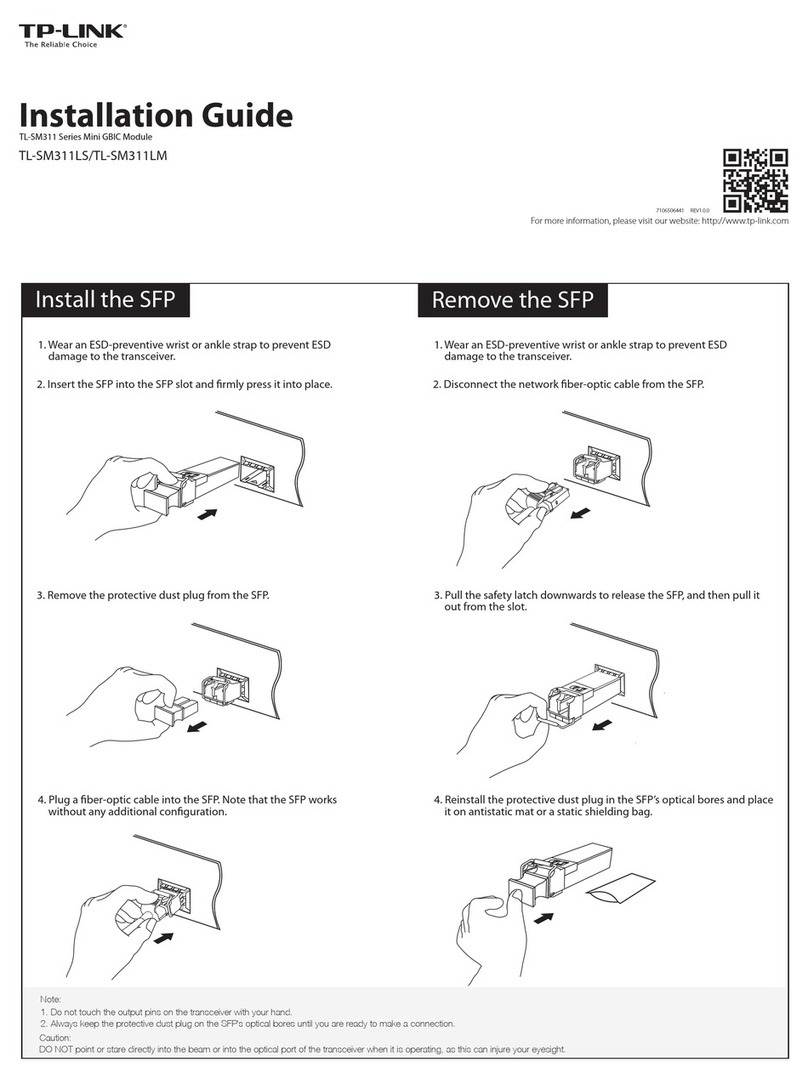
TP-Link
TP-Link TL-SM311LS installation guide
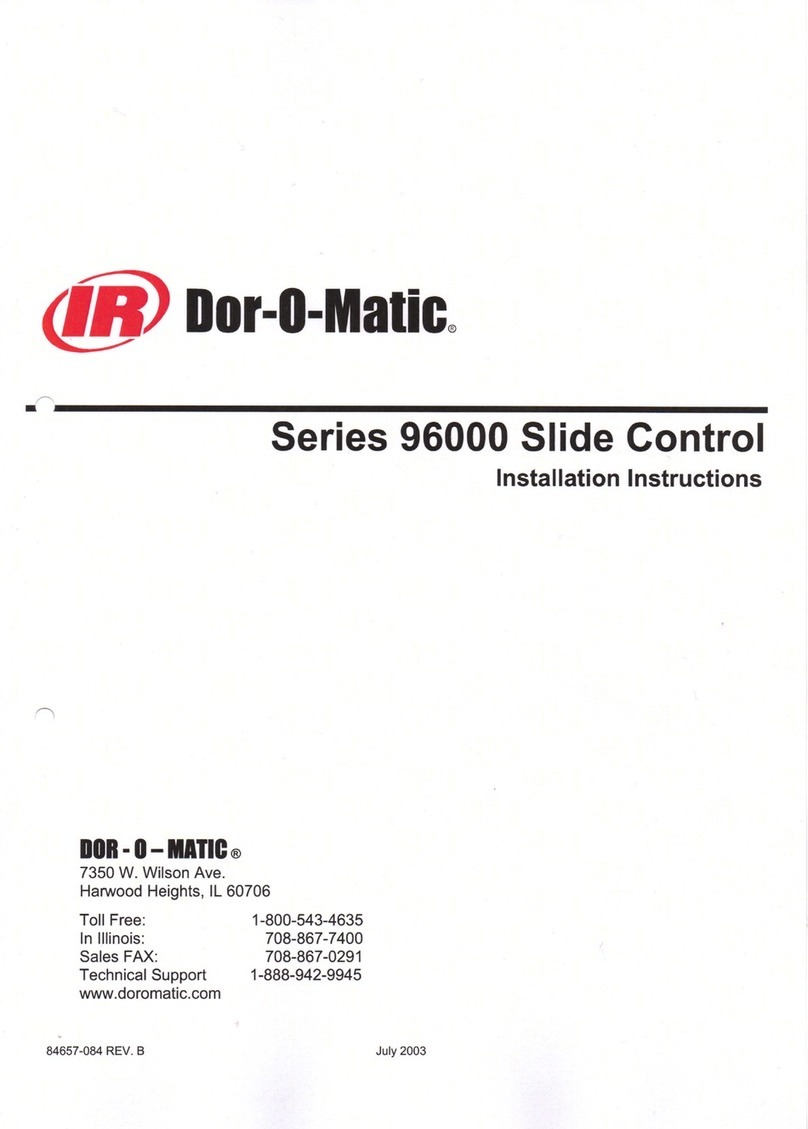
Ingersoll-Rand
Ingersoll-Rand Dor-O-Matic 96000 Series installation instructions
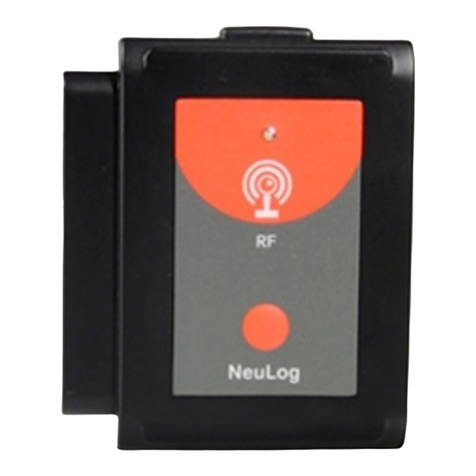
NeuLog
NeuLog RF-200 Guide

Siemens
Siemens SITOP UPS1600 Getting started
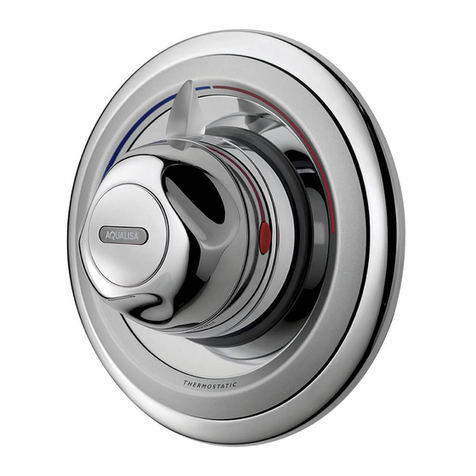
Aqualisa
Aqualisa Aquavalve 609 Thermo installation instructions
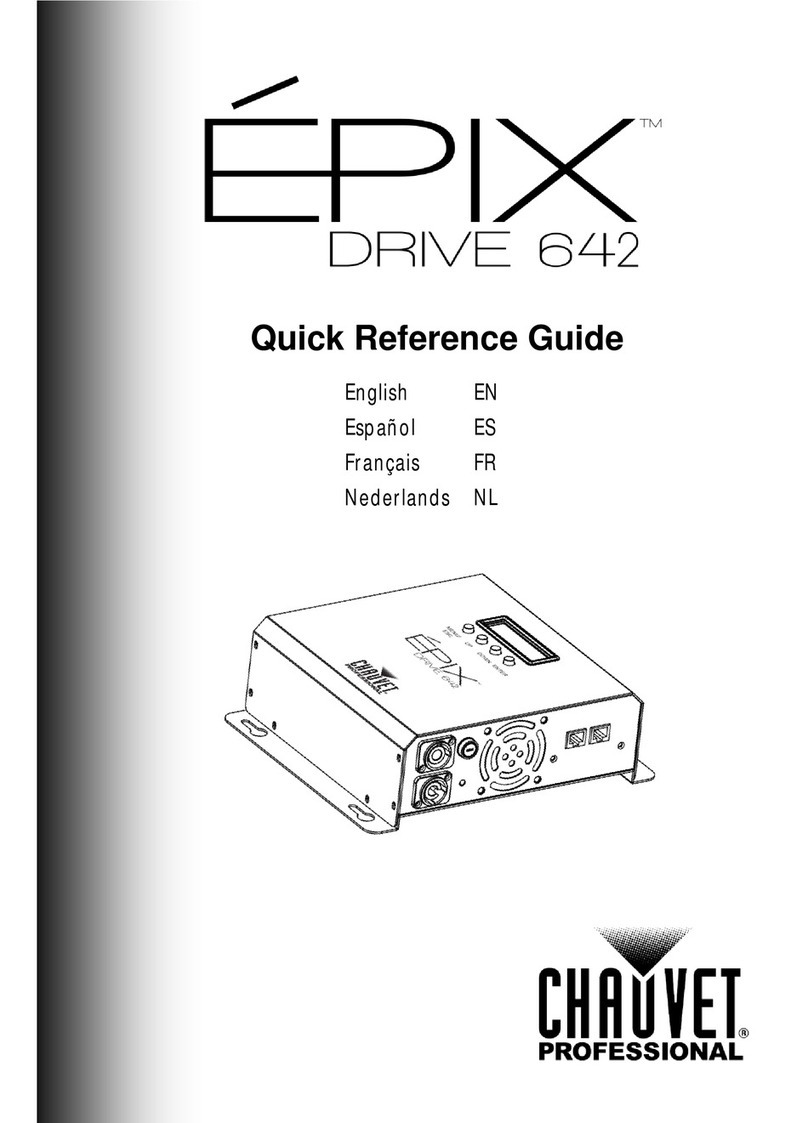
Chauvet
Chauvet Epix Drive 642 Quick reference guide
